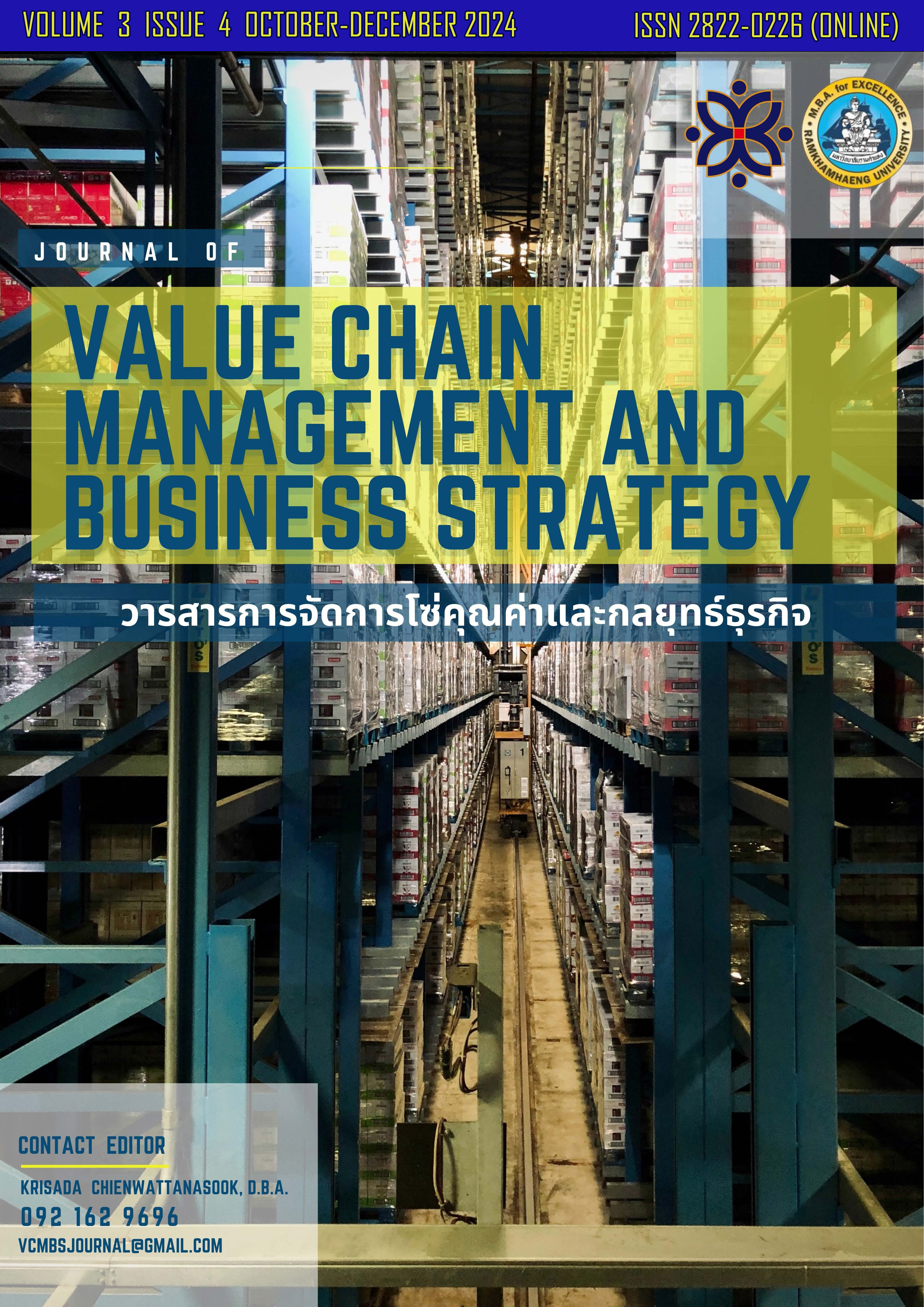MARKETING MIX FACTORS AND BRAND EQUITY INFLUENCING THE REPURCHASE DECISION OF THREE LADY COOKS CANNED FISH PRODUCTS AT MAKE-TO-ORDER RESTAURANTS IN PATHUM THANI PROVINCE
Keywords:
Marketing Mix Factors, Brand Equity, Repurchase DecisionAbstract
The purpose of this study is to examine the marketing mix factors and brand equity that influence the decision to repurchase Three Lady Cooks canned fish products among make-to-order restaurant operators in Pathum Thani province. The sample consisted of 280 make-to-order restaurant operators who were selected through convenience sampling by conducting surveys in different districts with participants who were willing to respond to questionnaires. The research instrument was a structured questionnaire and the data was analyzed using Partial Least Squares Structural Equation Modeling (PLS-SEM).
The results showed that the marketing mix factors significantly influence the decision to repurchase Three Lady Cooks canned fish at the statistical significance level of 0.000 with a path coefficient of .437. Similarly, brand equity has a significant influence on the decision to repurchase these products at the statistical significance level of .000 with a path coefficient of .406. Together, these two factors account for 64.4% of the variance in the decision to repurchase. The results show how important it is for companies to focus on developing strategies related to the marketing mix, such as appropriate pricing and customer-oriented promotional activities. In addition, strengthening brand equity can enhance customer trust and loyalty, thereby increasing the repurchase intention of the target customer group.
References
กฤษฎาพร เอก. (2560). กลยุทธ์การตลาดร้านค้าปลีกไทยแบบดั้งเดิม. วารสารบัณฑิตศาส์น มหาวิทยาลัยมหามกุฏราชวิทยาลัย, 15(1), 32-45.
กฤษดา เชียรวัฒนสุข, เมธวี เพิ่มทรัพย์, ณรงค์พล ปัญญา และอนภิชฌา เกรียงเกร็ด. (2566). คุณค่าตราสินค้าและส่วนประสมการตลาดที่ส่งต่อการตัดสินใจซื้อซ้ำผลิตภัณฑ์น้ำพริกเผาไทยของผู้ประกอบการร้านอาหารตามสั่งในจังหวัดปทุมธานี. วารสารนวัตกรรมการศึกษาและการวิจัย, 7(3), 955-967.
ลงทุนแมน. (2560). ประวัติศาสตร์ ปลากระป๋อง. https://www.longtunman.com/3204
สำนักงานนโยบายและยุทธศาสตร์การค้า กระทรวงพาณิชย์. (2566). สถานการณ์ธุรกิจร้านอาหารและเครื่องดื่มในประเทศไทย “ความท้าทาย และการปรับตัว เพื่อความอยู่รอดของร้านอาหารและเครื่องดื่ม”. https://uploads.tpso.go.th/แนบ%20รายงานฉบับเต็ม_ร้านอาหาร%20Rev1.pdf
อร่าม เขตคาม, ฑัตษภร ศรีสุข, และนภสินธุ พรมวิเศษ. (2566). พฤติกรรมของผู้บริโภคและกลยุทธ์ทางการตลาดที่ส่งผลต่อการใช้บริการร้านค้าปลีกสมัยใหม่ ประเภทร้านสะดวกซื้อของผู้บริโภคในจังหวัดขอนแก่น. วารสารลวะศรี มหาวิทยาลัยราชภัฏเทพสตรี, 7(2), 1-17.
Aaker, D. A. (1996). Building strong brands. Free Press.
Bhattacherjee, A. (2001). Understanding information systems continuance: An expectation-confirmation model. MIS Quarterly, 25(3), 351-370. https://doi.org/10.2307/3250921
Discover. (2024). ความนิยมของอาหารกระป๋องจากประเทศไทยในตะวันออกกลาง. https://www.dhl.com/discover/th-th/b2b-advice/b2b-e-commerce-advice/canned-food-from-thailand-to-export-to-the-middle-east
Fornell, C., & Larcker, D. F. (1981). Evaluating structural equation models with unobservable variables and measurement error. Journal of marketing research, 18(1), 39-50. https://doi.org/10.2307/3151312
Hair, J. F., Black, W. C., Babin, B. J., & Anderson, R. E. (2010). Multivariate data analysis (7th ed.). Prentice Hall.
Henseler, J., Hubona, G., & Ray, P. A. (2016). Using PLS path modeling in new technology research: updated guidelines. Industrial management & data systems, 116(1), 2-20. https://doi.org/10.1108/IMDS-09-2015-0382
Keller, K. L. (1993). Conceptualizing, measuring, and managing customer-based brand equity. Journal of Marketing, 57(1), 1-22. https://doi.org/10.1177/002224299305700101
Keller, K. L. (2013). Strategic brand management: Building, measuring, and managing brand equity (4th ed.). Pearson Education.
Kotler, P., & Armstrong, G. (2018). Principles of marketing (17th ed.). Pearson Education.
Kotler, P., & Keller, K. L. (2016). Marketing management (15th ed.). Pearson.
Markeeteer. (ม.ป.ป.). แบรนด์ปลากระป๋องที่ได้รับความนิยมสูงสุด (ทั่วประเทศ). https://marketeeronline.co/wp-content/uploads/2021/09/No.1-Brand-2020-2021-Research-Caned-Fish.pdf
Oliver, R. L. (1999). Whence consumer loyalty?. Journal of Marketing, 63(Special Issue), 33-44. https://doi.org/10.1177/00222429990634s105
Ryu, K., Lee, H., & Gon Kim, W. (2018). The influence of the quality of food, service, and environment on customer satisfaction and behavioral intention in quick-service restaurants. International Journal of Hospitality Management, 35, 203–211. https://doi.org/10.1177/1096348009350624
Thai Rath Money. (2023). ttb คาดตลาดสินค้าอุปโภคบริโภคขยายตัวอีก 5.5% ในปี 66 แนะ SME รับมือพร้อมโต. https://www.thairath.co.th/money/personal_finance/banking_bond/2683521
Zeithaml, V. A. (1988). Consumer perceptions of price, quality, and value: A means-end model and synthesis of evidence. Journal of Marketing, 52(3), 2-22. https://doi.org/10.2307/1251446
Downloads
Published
How to Cite
Issue
Section
License
Copyright (c) 2024 Journal of Value Chain Management and Business Strategy

This work is licensed under a Creative Commons Attribution-NonCommercial-NoDerivatives 4.0 International License.




